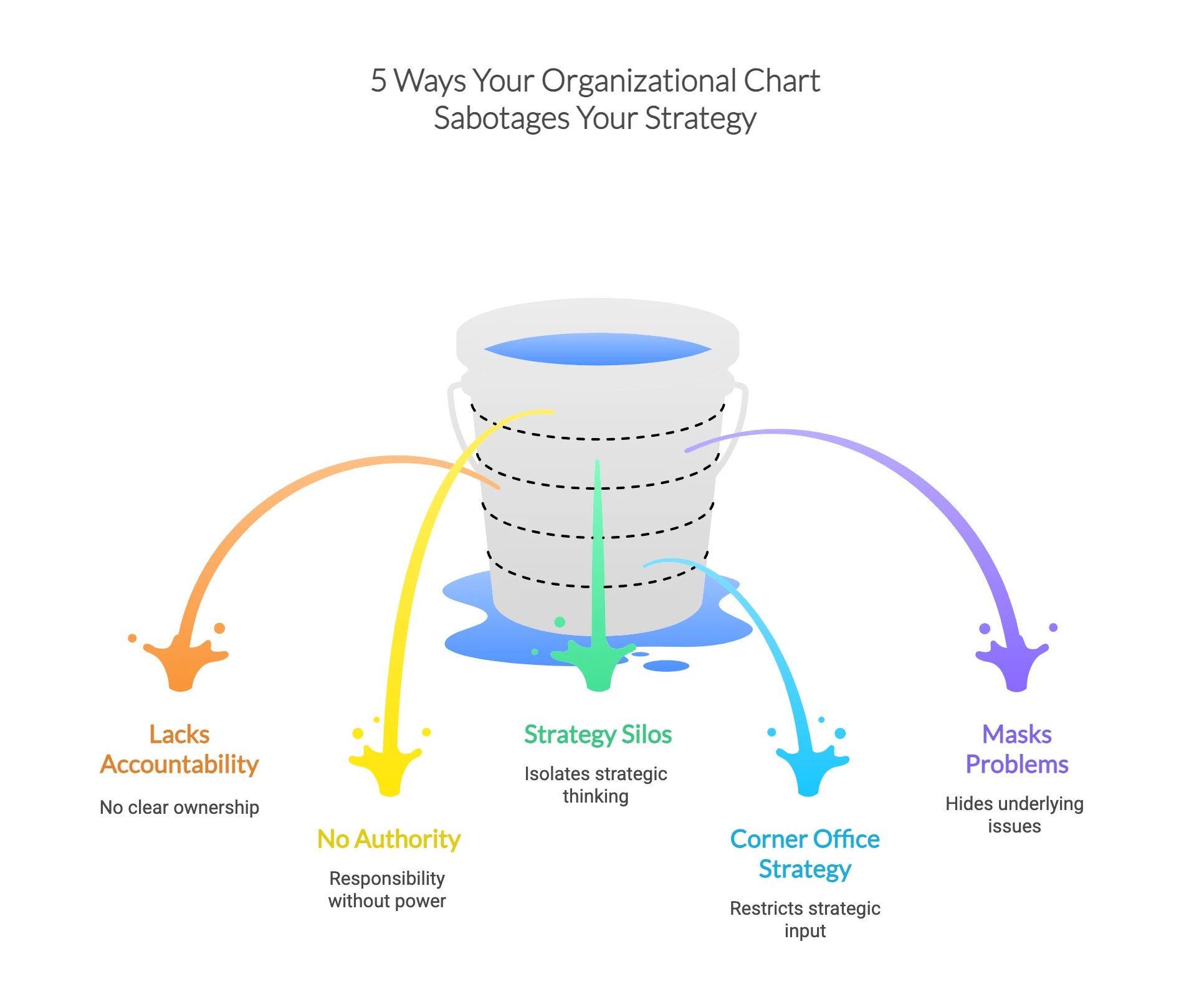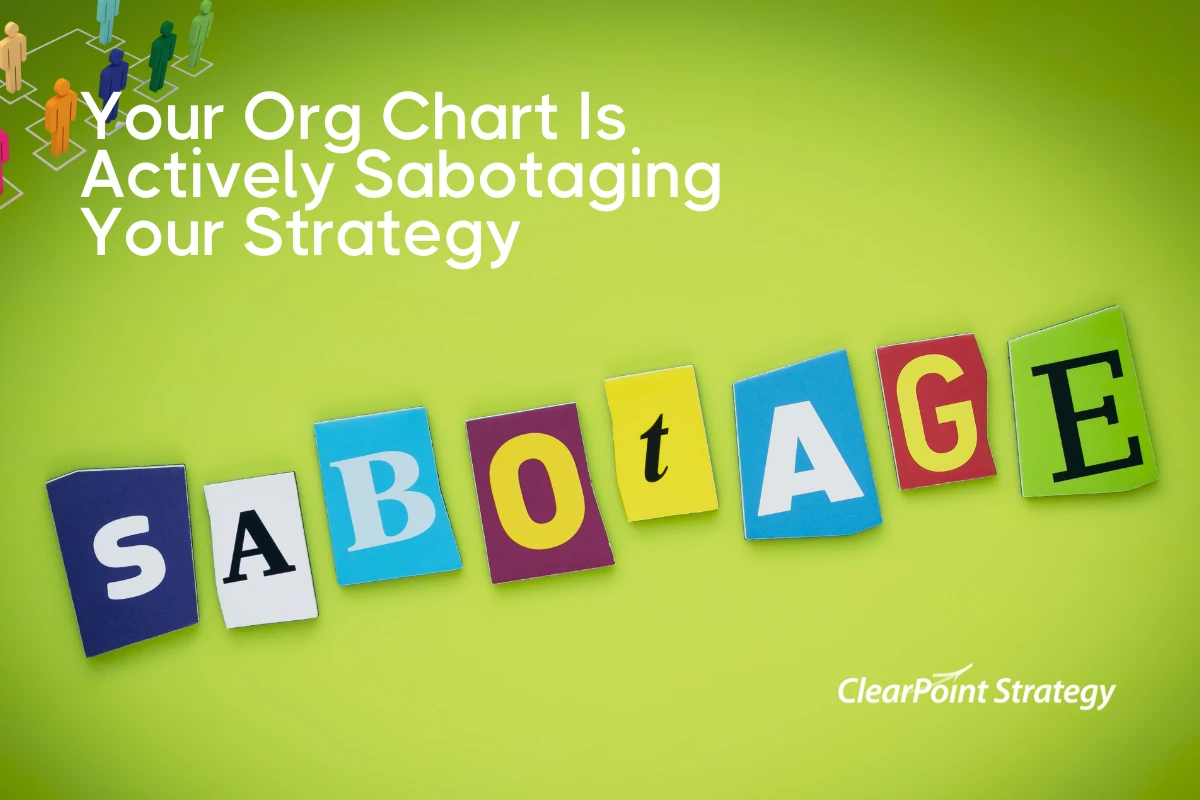Struggling to understand why your strategy consistently fails? Here’s one reason you may not have explored.
When a strategy falls apart, we love to blame the usual suspects: poor execution, lack of resources, maybe even a flawed vision. But what if the real culprit isn’t the plan itself?
What if your org chart is the saboteur?
Most organizations are structured for operational efficiency, not strategic agility. In today’s world, that’s a big problem. Strategic initiatives span departments, require cross-functional input, and depend on rapid, coordinated execution. Yet the traditional hierarchy treats strategy like a report that trickles down from the top.
That disconnect isn’t just inefficient. It’s destructive.
Let’s unpack the hidden ways your org chart might be undermining your strategy — and what you can do about it.
5 Ways Your Org Chart Is Sabotaging Your Strategy

1. It doesn’t support accountability.
Let’s start with the numbers: According to ClearPoint’s 2026 Megatrends report, 86% of assigned strategic owners made zero updates to their objectives or initiatives.
That’s not a typo.
Most so-called owners aren’t actually engaged.
In practice, what we often see is a single central analyst managing all the updates across dozens of owners. This person, usually well-intentioned, is too far removed from the work to explain why performance is slipping or why a project is off track.
The result? A dashboard full of data and no story behind it.
This isn’t usually due to laziness or bandwidth. It’s structural. Org charts were never designed to reflect who actually drives strategic priorities. They reflect reporting lines, not accountability.
Fix: Set a process where owners are responsible for analysis and recommendations. Data can be imported automatically or added by a data analyst, but the owner needs to answer two questions: “What does it mean?” (analysis) and “What should we do about it?” (recommendations). AI can help, but the owner should be knowledgeable about it and engaged in the outcome.
Want more data on how leading organizations plan and execute strategy? Sign up to get ClearPoint’s Megatrends report on Nov. 1.
2. It assigns responsibility but not real authority.
Here’s the trap: Many organizations assign strategic responsibilities to mid-level staff who don’t have the authority to make real changes.
You’ll see them updating KPIs, status fields, and initiative comments. But if they need to redirect resources or escalate an issue? That requires someone higher up — someone who may never open the strategic plan at all.
That leads to performative reporting. Everyone checks the box, but nothing changes.
Fix: Align ownership with decision-making power. If someone is accountable for results, give that person the authority to act on them.
3. It silos your strategy.
The data gets worse: More than 90% of strategic objectives have zero collaborators. Zero.
High-performing organizations, on the other hand, consistently have 3.5 collaborators. That means three people are focused on each strategic priority. These teams share ownership, provide context, and help each other overcome barriers.
Traditional org charts silo teams. Strategy doesn’t respect those silos.
Initiatives that span marketing, finance, and IT, for example, will die unless they’re supported by cross-functional ownership.
Fix: Build strategic teams that cut across the org chart. Assign collaborators intentionally, not incidentally.
4. It restricts strategy to the corner office.
In many organizations, strategy lives in a corner office — literally. It’s the domain of the executive team, the strategy office, or the PMO.
But the people doing the work? They’re two or three layers down the chart.
This gap creates a broken feedback loop. Strategy becomes abstract. Operations become siloed. And the two rarely meet.
Fix: Embed strategic ownership at every level. Don’t just cascade goals; cascade context. When frontline managers understand strategic priorities, they can execute with intent.
5. It masks problems.
One of the most frustrating outcomes of a bad org structure is how well it hides stalled work.
The Megatrends data shows that initiatives and milestones are frequently assigned to people who have no role in their execution. Updates are submitted by proxies, often administrative staff or analysts, who can report that something is delayed but can’t do anything about it.
That creates the illusion of progress while masking serious issues.
Fix: Assign accountability based on actual involvement. Owners should be close enough to the work to identify problems and resolve them.
How to Redesign Strategy Ownership
What’s the takeaway from all this?
I’m not suggesting that you throw out your org chart. Instead, supplement it with a new layer of strategic structure:
- Assign owners based on who does the work, not who holds the title.
- Use collaboration patterns to identify hidden influencers and informal leaders.
- Make milestone-level accountability a norm.
- Design scorecards to reflect cross-functional responsibilities.
It’s not about flattening the org chart. It’s about aligning accountability with execution.
I’ve worked with organizations that had world-class org charts on paper. But behind the scenes, the structure was stifling progress.
At ClearPoint, we help teams map their strategy execution to the people actually driving the work. Often that means moving away from department-centric scorecards and toward cross-functional accountability models.
When one ClearPoint client restructured ownership around involvement instead of hierarchy, their initiative completion rate jumped from 28% to over 60% in a year.
Is your org chart standing in the way of your goals?
If your strategy keeps stalling, look beyond your vision to diagnose the problem. It might be due to an ineffective organizational structure as it relates to strategy.
Org charts are great for managing operations. But strategy demands flexibility, collaboration, and distributed ownership — all things you can accomplish with ClearPoint. (Get a demo and see for yourself!)
The fix isn’t easy, but it is clear: Give strategy to the people doing the work. Only then can it actually move forward.

.svg)



![What's The Exact Right Number Of KPIs To Track? [DATA]](https://cdn.prod.website-files.com/637e14518f6e3b2a5c392294/6933449aba311e40db9ed2fa_what-is-the-exact-right-number-of-kpis-to-track-blog-header.webp)

